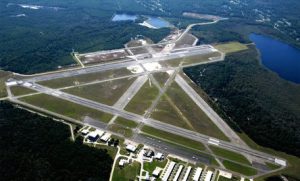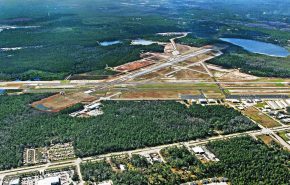With a history ranging from military flight training to corporate jets, the Flagler Executive Airport in Florida is undergoing a major construction effort to replace aging infrastructure, expand capacity, and increase operations. The project is part of a multi-million dollar airport development program to provide a safe, efficient, and expanded use of the airfield to support the surrounding community.

Image courtesy of Flagler County Historical Society
During World War II, the US Navy constructed auxiliary airfields—termed “outlying fields”—for flight training away from the risks of air traffic associated with airports. The Florida coast was checkered with such military facilities, one notably called Naval Outlying Field Bunnell.
With four paved runways to support training operations from both the Daytona Beach and Jacksonville Naval Air Stations, the field was simple and crude by today’s aviation standards. The Federal Aviation Administration (FAA) didn’t exist, standards that regulated airstrip construction were not universally accepted, and safety was not the primary concern as it is today. In 1947, after the war had ended, the US Navy gave the airfield to Flagler County and it became a public-use general aviation airport that fell into relative obscurity.
Today, that military facility—now known as Flagler Executive Airport—is served by one of the busiest FAA Contract Towers in Florida, and is used by flight schools from nearby Daytona Beach and Jacksonville, locally based flight training schools, executive private jets, military aircraft, and general aviation aircraft. Out of 105 General Aviation airports in the State, the FAA ranks it as the fourth busiest in Florida, with 190,000 takeoff and landings per year. Having morphed in size, operation and name, Flagler Executive Airport is now undergoing a major expansion project that has been in planning for over a decade.
Meeting Aviation Construction Requirements

Image courtesy of Halifax Paving Inc.
The ground-breaking ceremony was held on February 6, 2017 for construction of a 5,500-foot runway that will replace an existing 4,999-foot runway, one which has received only one minor rehabilitation in the last 50 years. The existing runway will be reconstructed and converted to a new parallel taxiway. GAI Consultants (GAI) was contracted by Flagler County for construction observation and administration services for the project.
Many of the airport’s business jets and other large aircraft operators are operating at less than 60 percent of their useful load due to the current runway length available at the airport. This yearlong project will allow more aircraft to use the airport at full capacity. As the aviation industry continues to grow in Florida, updates and expansion at airfields like Flagler help keep up with demand.
Regarding landside facilities, the configuration of the existing airfield, in particular Runway 11-29, constrains the ability of the airport to accommodate existing and future demand for aircraft storage facilities and other aviation-related support facilities. This project will address the present and future need for additional landside facilities including aircraft storage space (hangars and apron space), terminal space, and aviation/commercial real estate.
The Future of Aviation for Flagler County and the State of Florida
With funding from the FAA and Florida Department of Transportation, the Flagler Executive Airport expansion project is the biggest in the airport’s history, and a springboard to Flagler County’s economic development plan. Having a best-in-class corporate jet facility gives the County an edge in attracting new businesses to the area.
Contact Community Infrastructure Business Sector leader Kathy Leo, PE, 321.319.3095, for more information about GAI’s airport infrastructure engineering and development services, and learn more about GAI’s Aviation group.
Palm Coast, FL
- Environmental mitigation and permitting for the project which included:
- Excavating over 250 gopher tortoise burrows and relocating the 70 gopher tortoises found to the receiving bank, Drake Ranch, in Ocala, Florida
- Mitigation of almost 20 acres of wetlands
- Obstruction removal and tree clearing to accommodate the new approaches for the relocated Runway 11-29
- Grading and drainage improvements for all aspects of this project, including compliance with standard Runway Safety Area grading requirements
- Construction of Runway 11-29 at a length of 5,500 linear feet
- Construction of a new parallel Taxiway G at the same alignment as existing Runway 11-29, 400 feet north of proposed relocated Runway 11-29
- Full depth construction and reconstruction of all new airfield pavements using a lime rock base course and a bituminous asphalt surface
- New LED edge lighting, LED signage, and pavement markings for Runway 11-29, new Taxiway F, and new Taxiway G
- Installation of a 730 linear foot, 10’ x 6’ precast concrete box culvert under the new Runway and parallel taxiway to preserve an existing drainage canal serving the airport and the surrounding area
- Demolition of existing unused pavement to offset increases in impervious pavement


